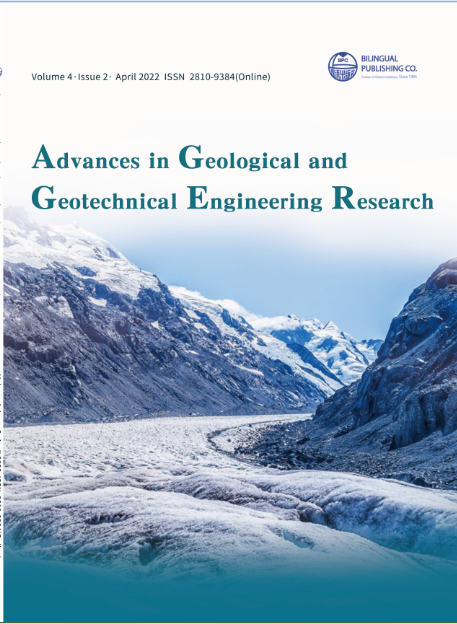-
148
-
144
-
138
-
121
-
120
Assessment of Geotechnical Properties of Laki Limestone for Coarse Aggregate, Nooriabad, Jamshoro Sindh, Pakistan
DOI:
https://doi.org/10.30564/agger.v4i2.4545Abstract
Present study is aimed at assessment of geotechnical properties of Laki limestone as coarse aggregate which is being quarried in Nooriabad area, Sindh, Pakistan. Coarse aggregate samples (n=20) of limestone were collected for the evaluation of physico-mechanical properties of the aggregate. Petrographic analysis revealed that the aggregate comprises of hard, compact, massive, crystalline and fossiliferous limestone. It is devoid of any reactive silica (chert, chalcedony) and other harmful constituents like clays or organic matter. Average values of specific gravity, absorption,bulk density, void content and combined index (EI + FI) of collected samples are 2.5, 2.1%, 1.54 g/cc, 38.55% and 13.04% respectively. The values of specific gravity (2.3-2.9), absorption (0-8%), bulk density (1.28 g/cc-1.92 g/cc) and void content (30%-45%) are varying within the range of normal weight aggregate as per American concrete institute (ACI)specifications. On the other hand, absorption values of aggregate samples are slightly higher (2.1%) than the reference range (2%) but meet other requirements. Mechanical properties including aggregate impact value (8.58%), aggregate crushing value (26.66%), Loss Angeles abrasion value (24.77%), sodium sulfate soundness (4.72%), water soluble sulfate (0.006%) and water soluble chloride (0.005%) are found to be within corresponding guidelines set by ASTM. On the other hand, average carbonate content is found to be 89.64% indicating that Laki limestone is of slightly low purity. Except absorption, all physical and mechanical properties lie within specified ranges. It is concluded that Laki limestone is suitable for use as road aggregate and concrete mix design.
Keywords:
Laki limestone; Coarse aggregate; Geotechnical properties; NooriabadReferences
[1] Smith, M.R., Collis, L., (Eds.), 2001. Aggregates: sand, gravel and crushed rock aggregates for construction purposes. Geological Society.
[2] Kosmatka, S., Kerkhoff, B., Panarese, W., 2003. Aggregates for Concrete, Design and Control of Concrete Mixtures. 14th Ed. Portland Cement Association. USA.
[3] Abbas, S., Munir, M.J., Kazmi, S.M.S., et al., 2017. Engineering characteristics of widely used coarse aggregates in Pakistan: a comparative study. Pakistan Journal of Engineering and Applied Sciences.
[4] Mitchell, C., 2015. Construction aggregates: evaluation and specification.
[5] British Geological Survey, 2013. Construction aggregates: Mineral Planning Factsheet. British Geological Survey. pp. 31.
[6] Hartley, A., 1974. A review of the geological factors influencing the mechanical properties of road surface aggregates. Quarterly Journal of Engineering Geology. 7(1), 69-100.
[7] Alexander, M., Mindess, S., 2010. Aggregates in concrete. CRC Press.
[8] Munir, M.J., Qazi, A.U., Kazmi, S.M.S., et al., 2016. A literature review on alkali silica reactivity of concrete in Pakistan. Pakistan Journal of Science. 68(1), 53-62.
[9] Ayub, M., Ali, Q., Shahzada, K., et al., 2012. Engineering assessment of coarse aggregates used in Peshawar. International Journal of Advanced Structures and Geotechnical Engineering. 1(2), 61-64.
[10] ASTM C295/C295M-19, 2019. Standard Guide for Petrographic Examination of Aggregates for Concrete, ASTM International, West Conshohocken, PA. https://www.astm.org.
[11] Lesueur, D., Petit, J., Ritter, H.J., 2013. The mechanisms of hydrated lime modification of asphalt mixtures: a state-of-the-art review. Road materials and pavement design. 14(1), 1-16.
[12] Ahsan, N., Baloch, I.H., Chaudhry, M.N., et al.,2000. Strength Evaluation of Blends of Lawrencepur, Chenab andRavi Sands with Lockhart and Margala Hill Limestones for use in Concrete. Special Issue Pak. Muse. Nat. Hist.Pakistan Science Foundation.pp. 213-240.
[13] Shah, S.I., 2009. Geological Survey of Pakistan.Stratigraphy of Pakistan. 22, 245-273.
[14] ASTM D75/D75M-19, 2019. Standard Practice for Sampling Aggregates, ASTM International,West Conshohocken, PA. https://www.astm.org.
[15] Kazmi, A.H., Jan, M.Q., 1997. Geology and tectonics of Pakistan. Graphic publishers.
[16] British Standards, 1990. Testing Aggregates, Method for determination of Aggregate Impact Value (AIV), BS 812, Part 112.
[17] ASTM C131/C131M-20, 2020. Standard Test Method for Resistance to Degradation of Small-Size Coarse Aggregate by Abrasion and Impact in the Los Angeles Machine, ASTM International, West Conshohocken, PA. https://www.astm.org.
[18] ASTM C88/C88M-18, 2018. Standard Test Method for Soundness of Aggregates by Use of Sodium Sulfate or Magnesium Sulfate, ASTM International,West Conshohocken, PA. https://www.astm.org.
[19] ASTM D4373-21, 2021. Standard Test Method for Rapid Determination of Carbonate Content of Soils, ASTM International, West Conshohocken, PA. https://www.astm.org.
[20] Aashto, T., 2014. Standard Method of Test for Specific Gravity and Absorption of Coarse Aggregate.
[21] Neville, A.M., 2000. Properties of Concrete 4th ed.Pearson Education Asia Pte.Ltd. Edinburgh, U.K. pp. 844.
[22] Islam, M.J., Meherier, M.S., Islam, A.K.M.R., 2016. Effects of waste PET as coarse aggregate on the fresh and harden properties of concrete. Construction and Building Materials. 125, 946-951.
[23] Neville, A.M., 2012. Properties of Concrete (4th Ed) Pearson Education Asia Pte.Ltd. Edinburgh, UK. pp.1-872.
[24] Fookes, P.G., Collis, L., 1975. Problems in Middle East. Concrete. 9(7), 12-17.
[25] Hussain, A., Yanjun, Q., 2012. Evaluation of Dina Aggregates for Pavement Construction in Pakistan. Advanced Materials Research. 548, 239-242.
[26] Wu, K., Chen, B., Yao, W., et al., 2001. Effect of coarse aggregate type on mechanical properties of high- performance concrete. Cement and Concrete Research. 31(10), 1421-1425.
[27] Fookes, P.G., Gourley, C.S., Ohikere, C., 1988. Rock Weathering in Engineering Time. Quarterly Journal of Engineering Geology. 21, 33-57.
[28] Kamal, M.A., Sulehri, M.A., Hughes, D.A.B., 2006. Engineering characteristics of road aggregates from northern Pakistan and the development of a toughness index. Geotechnical & Geological Engineering.24(4), 819-831.
[29] Aashto, T., 2003. Standard Method of Test for Soundness of Aggregate by Use of Sodium Sulfate or Magnesium Sulfate.
[30] Dunham, R.J., 1962. Classification of carbonate rocks according to depositional textures.
Downloads
How to Cite
Issue
Article Type
License
Copyright © 2022 Sumaira Asif Khan, Adnan Khan

This is an open access article under the Creative Commons Attribution-NonCommercial 4.0 International (CC BY-NC 4.0) License.




 Sumaira Asif Khan
Sumaira Asif Khan





